|
|
Golden Apple
The Mayan Omen
by Goro (goroadachi.com & supertorchritual.com)
October 02, 2012

Key Themes
- Royal, pregnancy/baby, Grail bloodline (resurrection)
- Martian Resurrection (life, panspermia, phoenix)
- "Birthquakes" (planetary pregnancy/birth expression)
- Plus: Underworld, Babylon/Tower of Babel; Venus; etc.
Projected Window
"...I'm going to go ahead and say that I see the latter part of August as a window for big things. Anchor dates ~August 24 and 29." - Aurora Code 2012 (7/21/2012)
"...I'm expecting a major development or impact related to all of this in some way around late August (anchor dates Aug 23-24 & 29)." - Olympics & Martian Resurrection (8/03/2012)
And now a brief summary of what has transpired...
since the Olympics.
* * *
Galactic Phoenix
Time: August 15, 2012
Themes: Phoenix/resurrection, Birth

Aug 15 Extreme Galaxy Cluster Birthing Stars at Excessive Rate
Aug 15 "Phoenix" Galactic cluster's 'starburst' surprise
Aug 15 Record-Breaking "Phoenix" Cluster
Phoenix and birthing. Echoing London...
Martian Coronation
Time: August 19, 2012
Themes: Mars, British Royal Family, Olympics
 
Aug 19 Curiosity Fires First Laser Beam at Rock "Coronation"
Aug 19 Pew! Pew! Pew! Curiosity Zaps Mars Rock with Laser
Mars and "Coronation" (name of the rock). Echoing London...

From Etemenanki's Aurora Code 2012 (7/21/2012):
...Here we are in 2012, just days away from the London Olympics, and "signs" such as the Aurora mass shooting keep pointing to the same storyline, the focus more on royal pregnancy than coronation per se though that's exactly what we see depicted in the London Olympic logo (as I interpreted it back in 2007)...
The Martian rock also alludes to the "Stone of Scone" aka "Stone of Destiny" aka "Coronation Stone" in Scotland where Diana-William-(Kate)-baby's Stuart royal bloodline originally ruled on the throne.


Having traditionally been associated with Jacob's pillow stone and through which Jacob's Ladder ("stairway to heaven"), the Coronation Stone is more or less analogous to a "stone fallen from heaven" making it interchangeable with the likes of the Grail and the Benben Stone which was the archetypal pyramid capstone...
 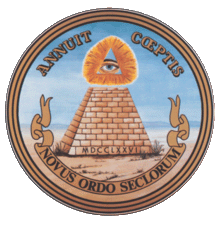
On September 22-24, the first rock NASA selected for Curiosity to physically touch and examine on Mars was pyramid-shaped.

Sep 21 Curiosity Targets Unusual Rock
Sep 24 Curiosity Touches 1st Martian Rock
Sep 24 Curiosity Finishes Close Inspection of Rock Target
On Mars, these are literally "heavenly stones".
Marsquake
Time: ~August 17-20, 2012
Themes: Mars, Birthquake
Royal Triple X
Time: Aug 22~ & Sep 14~, 2012
Themes: British Royal Family, Olympics, pentagram

Aug 22 Naked Prince Harry photos published online
A few weeks later...

Sep 14 Duke and duchess sue French magazine Closer
Royalty and XXX (pornographic), a clever pun on the official designation of the London Olympics, "the Games of the XXX Olympiad" ("XXX" = "30").
 
- 2012 Olympics = Games of the XXX Olympiad
- Olympics logo containing 2 "Z"s & stylized "crown"
- ZZ Top 1999 'XXX' album cover featuring crown
- Prince William turns 30 (= XXX) in 2012
Like the Royal Wedding and many other key events surrounding William & Kate...

...Prince Harry's Vegas incident was pinpointed by a pentagram.


It was also celestially pinpointed by the Sun's conjunction with Leo's brightest star Regulus, also known as... "Prince."

This was a key data point in the forecasting of the late-August window (specifically mentioning these dates).
Death of Moonwalker
Time: August 25, 2012
Themes: British Royal Family (Diana), Birth
Highlighting not only the Moon goddess Diana...

...but also the Aurora mass shooting this summer on the 43rd anniversary of the historic Moon landing (July 20). As discussed before, "Aurora" happens to be the name of a pregnant girl in Babylon A.D. who gives birth to messianic twin babies.

Michael Jackson is another famous "Moonwalker" whose birthday August 29 coincides with our second anchor date of the window.
Martian William
Time: August 28, 2012
Themes: Mars, British Royal Family (William)

Aug 28 will.i.am teams with NASA to debut song from Mars
William (will.i.am) and Mars.... Just days after Curiosity's interaction with the Martian "Coronation Stone." Basically implying "Coronation of Martian Prince William" or more archetypally the rebirth of the Jacobite "Grail" bloodline on the throne.
The very next day, or simultaneously on August 28-29, the birth (water breaking) event took place...
The Isaac Code
Time: ~August 26-29, 2012
Themes: British Royal Family (Kate), Birth, Apple
Right on "August 29"...
 Aug 26 Isaac Death Toll In Haiti Rises To 9 Aug 26 Isaac Death Toll In Haiti Rises To 9
Aug 26 Tropical Storm Isaac Should Rival Hurricane Katrina
Aug 27 Eerie similarities: Isaac follows track of Katrina
Aug 27 Isaac churns in Gulf along Katrina's path
|
|
|
|
|

Aug 28 Isaac makes landfall in southeastern Louisiana
Aug 28 Isaac hits US Gulf Coast, heads for New Orleans
Aug 29 Hurricane Isaac makes 2nd landfall
Aug 29 Storm surge overtops levee, 12-foot flood...

Aug 30 Dam Failure Feared After Tropical Storm Isaac
Everyone could see that Isaac was a Katrina clone, ravaging the same region on the same date, exactly 7 years later. An echo anticipated in Aurora Code 2012 (7/21/2012):
August 29 - Babylon A.D. release date - adds to the pregnancy/birth theme as it is the birthday of the ancient Egyptian goddess Hathor, associated with the Milky Way/Nile and the flood ("water breaking") and considered a herald of imminent birth.
In 2005, August 29 was the exact date of New Orleans' "water breaking" impact moment when Hurricane Katrina made landfall there... right at the midpoint of a Galactic-Mayan timeline directly involving the year 2012.
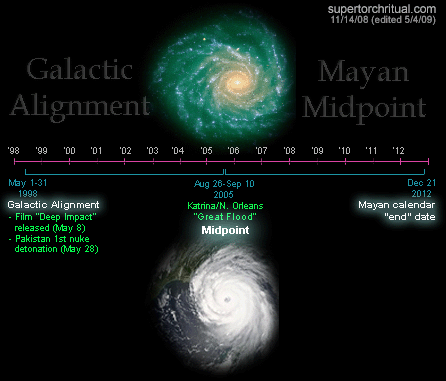
"Katrina" means "Catherine" as in Catherine"Kate" Middleton, i.e. the UK princess whose pregnancy/childbirth we've been long projecting for the Mayan window of 2012-2013 on our sites (Etemenanki/STRUG). [...]
"Maya" is today Mexico [as in "Gulf of Mexico"] and the name "Mexico" via Mextli refers to a "god of war" which in Roman mythology is Mars. "Mexico" via Mexihco means "Place at the Center of the Moon" implying "in the womb of Diana". [...]
...I'm going to go ahead and say that I see the latter part of August as a window for big things. Anchor dates ~August 24 and 29.

So we had the symbolism down beforehand and Isaac was a dramatic pattern fulfillment, the reality of which was confirmed and enhanced by additional eye-popping clues dropped on the other side of the Atlantic that same day...
It was the Paralympics opening ceremony in London on August 29 where Isaac Newton was being honored for his contribution to the expansion of human knowledge.
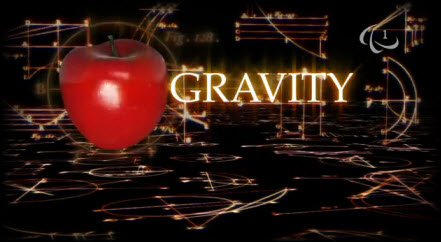
[Graphic from Paralympics opening ceremony]
Two Isaacs, same message. Isaac Newton is all about gravity and the (falling) apple, implying the following:
- "Gravity" is related to the Latin word gravidity (meaning "heavy") which is a scientific term for the state of pregnancy.
- "Apple" is the meaning of the term "Avalon" which is King Arthur's mythical "underworld" where he is said to be hibernating and would return from as the Once and Future King ("rebirth"), i.e. a drama unfolding at this time semi-literally through the rise of the Kate-William-baby trinity.

[Many apples during Paralympics opening ceremony]

A big exclamation mark came toward the end of the show in the form of a giant naked, pregnant woman based on an actual sculpture in London called "Alison Lapper Pregnant". I'm not kidding, see for yourself:

She was the centerpiece of the closing phase of the ceremony. For much of the duration of the show, however, the centerpiece was... the Moon.
The whole ceremony was lunar, and it was in London... together evoking Princess Diana. In this way, we were given another confirmation that the prevalent pregnancy/birth motif pertains mainly (but not exclusively) to the late princess's Arthurian descendants/family/bloodline. Kate Middleton while not related by blood is a worthy successor to Diana and is more than ready to bring a new life into this world with Prince William. My projection has always been that she would likely get pregnant in 2012 and give birth in the 2012-2013 time frame (naturally looking at 2013 now). We are talking " Grail bloodline" here and there was a blatant foreshadowing in the form of NASA's GRAIL twin probes entering orbit around the Moon right at the start of 2012 on New Year's Eve/Day. "GRAIL" here stands for " Gravity Recovery and Interior Laboratory".
As it happens August 29 is also New Year's Day ("1 Thoth") of the (Alexandrian) ancient Egyptian calendar. In ancient Egypt New Year's Day signified rebirth via the combination of the heliacal rising of Sirius and the annual inundation ("water breaking") of the Nile. Everything fits just beautifully. Pattern projected and fulfilled. At this stage there should be no denying that the pattern is real.
Golden Apple
We can start looking ahead using the same general pattern and specifically the golden apple which was conspicuously floating around at the opening ceremony on August 29. 
Thrown into a party, a golden apple becomes an unmistakable omen.... hinting at what amounts to a world war. Great chaos. That's the basic story of the Golden Apple of Discord in Greek mythology: goddess Discordia/Eris throws a golden apple with the inscription "for the fairest" into a wedding banquet, followed by a beauty contest, then the "abduction" of Helen as a direct consequence, sparking the Trojan War (ancient world war).
From my multicontextual point of view, it's no coincidence that the first impact event of 2012 was the Costa Concordia cruise ship disaster off Italy. "Concordia" is obviously the opposite (= upside down, like the wrecked ship) of "Discordia" (Eris) who threw the golden apple. Strong resonance there.
No coincidence especially if you take into account the fact that London was originally called "New Troy" according to legend...
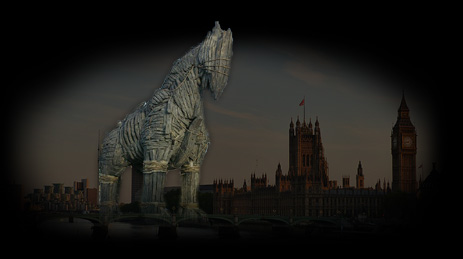
...and the fact that soon after the Paralympics great chaos was unleashed in the world starting around 9/11 (= big chaos/war date) coinciding with another big "Apple" event (iPhone 5):


Orange Alignment
Time: ~October 20, 2012
Themes: Golden apple/Orange, Chaos, Birthquake
For many years now we've been tracking what we call the "Orange Alignment" i.e. a heliocentric lining up of Venus, Sun and Mercury. I've shown many times before that when they come, we do feel their impact. It is my view that the next one coming up soon is a highly charged one... because, for one, in many languages the fruit orange is called... "golden apple".
 
The Orange Alignment will be formed in our solar system on ~October 20, 2012, like this:
Making it even more ominous, the alignment angle pinpoints the Earth's orbital position on January 12-13 (annual), which is the exact date of this year's Costa Concordia disaster (= Discordia => golden apple/orange) as well as the devastating Haiti earthquake (Birthquake) back in 2010. (Orange Alignments are often "earth changes" markers.)

That, to me, just does not look good. Some kind of big impact appears to be in the offing there (directly or indirectly) and I would expect it to continue to express the same underlying themes, but more intensely. Hopefully it's more about things like the Royal Pregnancy, Mars, etc. rather than severe earth changes, war, and such. There are obviously many possible scenarios and we may well be looking at multiple events (or just strong signals) unfolding simultaneously or in quick sequence.
I should also mention that there are other aspects of the whole golden apple business that points its temporal finger squarely at the year 2013. As well, before we even get there we'll have... certain things coming later this year which we'll need to talk about soon.
Enough for now. Thanks for reading!
https://www.goroadachi.com/etemenanki/golden_apple.html |
|
|
|
|
First, NYC/Long Island can be associated with 'knowledge' through the symbolisms of 'apple' ("Big Apple"), 'rose' (state flower), 'fire' (Statue of Liberty, its connection to Paris/'torch'), etc. and as we've seen in foregoing sections it's part of the 'ark' complex via VI-97. Furthermore from the 'apple' connection follows the notion of the 'serpent'. Now, all those 'knowledge'/Sirius connections of NYC can be transferred to Mars because, as illustrated in 'Babylon Matrix', NYC is also related to Mars, especially the Cydonia region with all the potentially artificial structures. Mars being red and circular is associatable with the 'apple', the red and round 'Big Apple' (NYC). Now, some might argue that the fruit Eve ate was not necessarily an 'apple', but we generally thought of it as an apple today and that has to count in symbolism. But there is a much more precise connection - the latitudes of NYC and Cydonia are exactly the same, 40.5~41N.
The events closely associated earlier with X-72 and more or less with the ark, the two random shootings in a library and school ('Resonance' #7 and 8), appear to back up the Mars-Sirius connection also. Those two similar events, only five days apart, occurred one on the Cydonian latitude and the other on the Sirius 'angle' latitude. The Mormon library shooting took place at ~40.5N, and the Colorado school shooting at ~39.5N. The name 'Salt Lake City', where the library shooting occurred, may be relevant also since mythologically the 'salt water' is of female - and Sirius is filled with female associations ('goddess', 'star of Women', etc.).
Moreover, Temple mentions in his book that "when making rhetorical allusion to the Dog Days, the Latins would often speak of Sirius being red at the time..." Now, this is quite significant for not only is Sirius described as 'red' like Mars, but the "Dog Days" would refer to a period in or around July - the exact time-frame indicated by Quatrain X-72.
The Sirius-correlated Argo also turns out to be very relevant here. Because the main mission of Jason, the leader of the Argonauts who has been identified as the "appeasing King"/"King of terror" of X-72 earlier, was to obtain the 'golden fleece', and in Temple's words, "Aries was definitely identified with the golden fleece". In case you don't know, Aries is the Greek Mars. Aries is also a sign of the zodiac, "ruled" by Mars, and it is classified as a 'fire sign' - correlating with the fire-knowledge symbolism. I should also point out that Mars is called 'fire star' in Japanese.
Moreover, Sirius/Isis' son Horus provides intriguing correlations. First, the Great Sphinx associated earlier with 'ark' was called by Egyptians "Horus of Horizon" which also happens to be a name given to Mars. And the word 'Cairo', where the Sphinx is (actually slightly west of Cairo), is derived from 'Mars'. Mars was also called 'Horus the Red'. And the word 'Heru' (Egyptian name for Horus) also has the meaning of 'face' - seemingly a reference to the infamous 'Face on Mars' at Cydonia! (So, as you can see, the Mars-Horus connection is quite obvious.) Next, Sirius/ark comes into the web of associations, as the Argo also relates to Horus (thus to Mars too) as the Greek derivation of Horus, 'Circe', plays a prominent role in the story of Argo. Also, as Temple hypothesizes, the names of the original captain of Argo, Herakles, and his protectress Hera may be derived from 'Heru' - the Egyptian name for Horus. Furthermore, we're told that Herakles/Hera is related to the word 'Seirios' from which we have the word 'Sirius' - strengthening the Mars-ark-Sirius connection. But as if it wasn't enough, Temple goes on to point out that 'Seirios' also has the meaning of 'fiery/scorching', that can easily be a reference to Mars.

And finally, Mars and Sirius are linked by the 'tetrahedral angle' of 19.5 degrees. '19.5 degrees' is one of the most significant notions derived from the supposed artificial structures of Cydonia that suggests their artificiality, according to investigators like Richard Hoagland ('The Monuments of Mars'). It is viewed as a definite 'signal in the noise' - some kind of a 'message' left there by some intelligence. This number, '19.5', is called t, the 'tetrahedral constant', because of  its significance in tetrahedral geometry (a tetrahedron is a pyramid shape composed of four equilateral triangular sides): the apexes of a tetrahedron when placed within a circumscribing sphere, one of the tetrahedron's apexes touching the south (or north) pole, the other three apexes touch the surface of the sphere at 19.5 degrees north latitude. So it is interesting that the Egyptian symbol for Sirius is a triangle which can be viewed as a 2-dimensional representation of a tetrahedron. its significance in tetrahedral geometry (a tetrahedron is a pyramid shape composed of four equilateral triangular sides): the apexes of a tetrahedron when placed within a circumscribing sphere, one of the tetrahedron's apexes touching the south (or north) pole, the other three apexes touch the surface of the sphere at 19.5 degrees north latitude. So it is interesting that the Egyptian symbol for Sirius is a triangle which can be viewed as a 2-dimensional representation of a tetrahedron.
https://www.goroadachi.com/etemenanki/1999-sirius.htm |
|
|
|
|
Columbus and the Templars
Was Columbus using old Templar maps when he crossed the Atlantic? At first blush, the navigator and the fighting monks seem like odd bedfellows. But once I began ferreting around in this dusty corner of history, I found some fascinating connections. Enough, in fact, to trigger the plot of my latest novel, The Swagger Sword.
To begin with, most history buffs know there are some obvious connections between Columbus and the Knights Templar. Most prominently, the sails on Columbus’ ships featured the unique splayed Templar cross known as the cross pattée (pictured here is the Santa Maria):
Additionally, in his later years Columbus featured a so-called “Hooked X” in his signature, a mark believed by researchers such as Scott Wolter to be a secret code used by remnants of the outlawed Templars (see two large X letters with barbs on upper right staves pictured below):
Other connections between Columbus and the Templars are less well-known. For example, Columbus grew up in Genoa, bordering the principality of Seborga, the location of the Templars’ original headquarters and the repository of many of the documents and maps brought by the Templars to Europe from the Middle East. Could Columbus have been privy to these maps? Later in life, Columbus married into a prominent Templar family. His father-in-law, Bartolomeu Perestrello (a nobleman and accomplished navigator in his own right), was a member of the Knights of Christ (the Portuguese successor order to the Templars). Perestrello was known to possess a rare and wide-ranging collection of maritime logs, maps and charts; it has been written that Columbus was given a key to Perestrello’s library as part of the marriage dowry. After marrying, Columbus moved to the remote Madeira Islands, where a fellow resident, John Drummond, had also married into the Perestrello family. Drummond was a grandson of Scottish explorer Prince Henry Sinclair, believed to have sailed to North America in 1398. It is, accordingly, likely that Columbus had access to extensive Templar maps and charts through his familial connections to both Perestrello and Drummond.
Another little-known incident in Columbus’ life sheds further light on the navigator’s possible ties to the Templars. In 1477, Columbus sailed to Galway, on the west coast of Ireland, from where the legendary Brendan the Navigator supposedly set sale in the 6th century on his journey to North America. While there, Columbus prayed at St. Nicholas’ Church, a structure built over an original Templar chapel dating back to around the year 1300. St. Nicholas’ Church has been compared by some historians to Scotland’s famous Roslyn Chapel, complete with Templar tomb, Apprentice Pillar, and hidden Templar crosses. (Recall that Roslyn Chapel was built by another grandson—not Drummond—of the aforementioned Prince Henry Sinclair.) According to his diary, Columbus also famously observed “Chinese” bodies floating into Galway harbor on driftwood, which may have been what first prompted him to turn his eyes westward. A granite monument along the Galway waterfront, topped by a dove (Columbus meaning ‘dove’ in Latin), commemorates this sighting, the marker reading: On these shores around 1477 the Genoese sailor Christoforo Colombo found sure signs of land beyond the Atlantic.
In fact, as the monument text hints, Columbus may have turned more than just his eyes westward. A growing body of evidence indicates he actually crossed the north Atlantic in 1477. Columbus wrote in a letter to his son: “In the year 1477, in the month of February, I navigated 100 leagues beyond Thule [to an] island which is as large as England. When I was there the sea was not frozen over, and the tide was so great as to rise and fall 26 braccias.” We will turn later to the mystery as to why any sailor would venture into the north Atlantic in February. First, let’s examine Columbus’ statement. Historically, ‘Thule’ is the name given to the westernmost edge of the known world. In 1477, that would have been the western settlements of Greenland (though abandoned by then, they were still known). A league is about three miles, so 100 leagues is approximately 300 miles. If we think of the word “beyond” as meaning “further than” rather than merely “from,” we then need to look for an island the size of England with massive tides (26 braccias equaling approximately 50 feet) located along a longitudinal line 300 miles west of the west coast of Greenland and far enough south so that the harbors were not frozen over. Nova Scotia, with its famous Bay of Fundy tides, matches the description almost perfectly. But, again, why would Columbus brave the north Atlantic in mid-winter? The answer comes from researcher Anne Molander, who in her book, The Horizons of Christopher Columbus, places Columbus in Nova Scotia on February 13, 1477. His motivation? To view and take measurements during a solar eclipse. Ms. Molander theorizes that the navigator, who was known to track celestial events such as eclipses, used the rare opportunity to view the eclipse elevation angle in order calculate the exact longitude of the eastern coastline of North America. Recall that, during this time period, trained navigators were adept at calculating latitude, but reliable methods for measuring longitude had not yet been invented. Columbus, apparently, was using the rare 1477 eclipse to gather date for future western exploration. Curiously, Ms. Molander places Columbus specifically in Nova Scotia’s Clark’s Bay, less than a day’s sail from the famous Oak Island, legendary repository of the Knights Templar missing treasure.
The Columbus-Templar connections detailed above were intriguing, but it wasn’t until I studied the names of the three ships which Columbus sailed to America that I became convinced the link was a reality. Before examining these ship names, let’s delve a bit deeper into some of the history referred to earlier in this analysis. I made a reference to Prince Henry Sinclair and his journey to North American in 1398. The Da Vinci Code made the Sinclair/St. Clair family famous by identifying it as the family most likely to be carrying the Jesus bloodline. As mentioned earlier, this is the same family which in the mid-1400s built Roslyn Chapel, an edifice some historians believe holds the key—through its elaborate and esoteric carvings and decorations—to locating the Holy Grail. Other historians believe the chapel houses (or housed) the hidden Knights Templar treasure. Whatever the case, the Sinclair/St. Clair family has a long and intimate historical connection to the Knights Templar. In fact, a growing number of researchers believe that the purpose of Prince Henry Sinclair’s 1398 expedition to North America was to hide the Templar treasure (whether it be a monetary treasure or something more esoteric such as religious artifacts or secret documents revealing the true teachings of the early Church). Researcher Scott Wolter, in studying the Hooked X mark found on many ancient artifacts in North American as well as on Columbus’ signature, makes a compelling argument that the Hooked X is in fact a secret symbol used by those who believed that Jesus and Mary Magdalene married and produced children. (See The Hooked X, by Scott F. Wolter.) These believers adhered to a version of Christianity which recognized the importance of the female in both society and in religion, putting them at odds with the patriarchal Church. In this belief, they had returned to the ancient pre-Old Testament ways, where the female form was worshiped and deified as the primary giver of life.
It is through the prism of this Jesus and Mary Magdalene marriage, and the Sinclair/St. Clair family connection to both the Jesus bloodline and Columbus, that we now, finally, turn to the names of Columbus’ three ships. Importantly, he renamed all three ships before his 1492 expedition. The largest vessel’s name, the Santa Maria, is the easiest to analyze: Saint Mary, the Virgin Mary, the mother of Jesus. The Pinta is more of a mystery. In Spanish, the word means ‘the painted one.’ During the time of Columbus, this was a name attributed to prostitutes, who “painted” their faces with makeup. Also during this period, the Church had marginalized Mary Magdalene by referring to her as ‘the prostitute,’ even though there is nothing in the New Testament identifying her as such. So the Pinta could very well be a reference to Mary Magdalene. Last is the Nina, Spanish for ‘the girl.’ Could this be the daughter of Mary Magdalene, the carrier of the Jesus bloodline? If so, it would complete the set of women in Jesus’ life—his mother, his wife, his daughter—and be a nod to those who opposed the patriarchy of the medieval Church. It was only when I researched further that I realized I was on the right track: The name of the Pinta before Columbus changed it was the Santa Clara, Portuguese for ‘Saint Clair.’
So, to put a bow on it, Columbus named his three ships after the Virgin Mary, Mary Magdalene, and the carrier of their bloodline, the St. Clair girl. These namings occurred during the height of the Inquisition, when one needed to be extremely careful about doing anything which could be interpreted as heretical. But even given the danger, I find it hard to chalk these names up to coincidence, especially in light of all the other Columbus connections to the Templars. Columbus was intent on paying homage to the Templars and their beliefs, and found a subtle way of renaming his ships to do so.
Given all this, I have to wonder: Was Columbus using Templar maps when he made his Atlantic crossing? Is this why he stayed south, because the maps showed no passage to the north? If so, and especially in light of his 1477 journey to an area so close to Oak Island, what services had Columbus provided the Templars in exchange for these priceless charts?
It is this research, and these questions, which triggered my novel, The Swagger Sword. If you appreciate a good historical mystery as much as I, I think you’ll enjoy the story.
|
|
|
|
|
| Santa Clara de Asís |
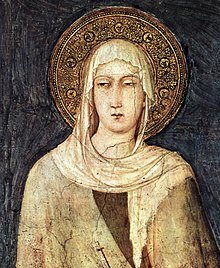
Clara de Asís
|
| Información personal |
| Nombre de nacimiento |
Chiara Scifi |
| Nacimiento |
16 de julio de 1194
Asís (Italia) |
| Fallecimiento |
11 de agosto de 1253 (59 años)
Asís (Italia) |
| Sepultura |
Basílica de Santa Clara (Asís)  |
| Religión |
Catolicismo |
| Familia |
| Padres |
Favarone Offreduccio y Ortolana de Asís |
| Información profesional |
| Ocupación |
Monja, autora, escritora de literatura religiosa, fundador de orden o congregación, místico, filósofa y monja clarisa  |
| Área |
Misticismo, oración y gestión  |
| Cargos ocupados |
Abadesa (desde 1215)  |
| Información religiosa |
| Canonización |
26 de septiembre de 1255, por el papa Alejandro IV |
| Festividad |
11 de agosto (rito romano) |
| Atributos |
Custodia, Báculo, Lirio |
| Venerada en |
Iglesia católica, Comunión anglicana, Iglesia luterana |
| Patronazgo |
Televisión
Comunicación a distancia
Mensajeros
Enfermedades de la vista
|
| Orden religiosa |
Orden de Santa Clara  |
|
|
|
|
|
|
|
|
|
11/6=august 11th = august (sixth month)
|
|
|
|
|
AUGUST 11TH=ST. CLARE OF ASSISI

Regulus is one of the brightest stars in the night sky, which is not only the "heart of the lion" but also "prince" (or "little king") as well as "the King", just as Jupiter is named after the king of the gods. It is highly significant therefore that Regulus and Jupiter will be in "royal" conjunction on ~August 11.

Remarkably ~August 11, 2015 is also pinpointed by a "Mayan financial crisis" time code I started highlighting back in February (STRUG) which is based on the Golden Ratio ("phi") and at least three major dates/events: 1) Transit of Venus (2004), 2) the day the US financial system almost came crashing down (9/14/2008), and 3) the "end" of the Mayan calendar (12/21/2012):
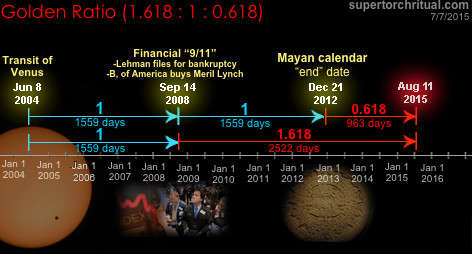

[Transit of Venus - June 8, 2004 & June 6, 2012 -
rare phenomenon of Venus passing in front of the Sun]
 Sep 14, 2008 Lehman Files for Bankruptcy; Merrill Is Sold Sep 14, 2008 Lehman Files for Bankruptcy; Merrill Is Sold
Sep 15, 2008 Crisis on Wall Street as Lehman Totters, Merrill Is Sold, AIG Seeks to Raise Cash
[Wikipedia - Global financial crisis in September 2008]
["Inside the Meltdown" (PBS) video]
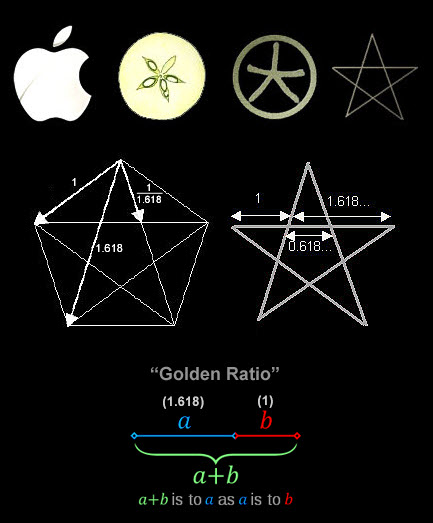
The financial crisis theme is underscored by an additional equidistant Mayan timeline coming from the May 6, 2010 "Flash Crash" (Dow Jones) pinpointing August 8, 2015, just 3 days before August 11:


[May 06, 2010 Dow freefalls almost 1,000 points, pulls back]
The point is not necessarily that we will have another such literal financial crisis in August 2015. But that we will have some notable event(s) heavily resonating with these things.
~~ UPDATE ~~
The pattern has been confirmed, as China's surprise move to devalue
its currency on August 11, 2015 destabilized global markets...
~~ END UPDATE ~~
[Original article resuming...]
On to the next set of time codes, with a temporal focus more on the latter half of August...
As I've noted many times in the past, Regulus is annually illuminated by the Sun on ~August 21–23…

And it just so happens that it coincides with the heliacal rising of Sirius specifically at the latitude of Paris (~August 22)! But that's not all...
This year it will also coincide with Venus's rebirth as the Morning Star around August 21. (Until mid August before its inferior conjunction Venus is in its Evening Star phase.) This of course connects right back to the Transit of Venus which is a very precise form of the Venus inferior conjunction (= Earth-Venus-Sun alignment) that always immediately precedes the birth of the Morning Star.
This is very important because "Morning Star" is the original meaning of the term/name "Lucifer". And it just so happens that in the movie Lucy released in July 2014 we see Lucy's driver's license expiring specifically on "August 24, 2015".


What's more, August 24 will be the anniversary of last year's big earthquake (8/24/2014) in the "phoenix city" San Francisco…

[Aug 24, 2014 Strongest quake in 25 years strikes San Francisco]

[San Francisco flag]
https://www.goroadachi.com/etemenanki/dogdays_prophecy.html
|
|
|
|
|
Pentagram pinpointing Enterprise arriving in the Big Apple...
Pentagram pinpointing Endeavour rolling through LA (and Dragon roaming the sky)...
(Note: My previous article Golden Apple highlighting the Trojan theme was posted hours before the armed conflict erupted. Pattern projection => fulfillment.) "It's all connected"...
SpaceX Marks the Spot (goroadachi.com) |
|
|
|
|
Olympics & Martian Resurrection
Babylon Baby, Grail Bloodline
& Genesis Total Recall
by Goro (goroadachi.com & supertorchritual.com)
August 03, 2012 (Updated Aug 14)

Preface
It was pretty good stuff we saw at the London Olympics Opening Ceremony on July 27. Perhaps not the most elegant opening ceremony we've seen as far as artistry and drama (that honor goes to Athens 2004), but more than adequate in terms of "whispering secrets" Enki-Prometheus style. Around here we weren't just watching, we were more actively engaged, anticipating pattern fulfillment. And boy did we ever get one!
Our multicontextual pattern assessment - most recently (re-)done in Aurora Code 2012 (July 21) - had indicated the following set of powerful themes to be in play during this period:
- Royal & Martian pregnancy/baby, Arthurian/Grail bloodline
- Intertwined issues of Mars (missions, life, panspermia, resurrection) & baby of Prince William & Kate Middleton
- Babylon/Tower of Babel
- Venus/Morning Star/Lucifer
- Sun (solar cycle, solar wind/flares/CMEs, aurora)
- And more...

If you watched the opening ceremony, you know how they turned out. Or maybe not. While some of the confirmations were fairly obvious, in your face even, like the "Tower of Babel" and the "Babylon Baby," there were other parts probably too cryptic for the average observer to discern. Especially the "Martian panspermia" segment. I am writing this article to elucidate what "really" happened at the Olympics opening ceremony, what was whispered by "Enki" from behind the wall, so everyone can get on the same page with regard to the true level of pattern fulfillment witnessed there, and what it could mean for the future. [Update: A new section discussing the closing ceremony has been added at the end of this article on August 14.]
The situation is that we have hidden patterns converging, uniting past, present and future... for a Total Recall of Martian Genesis.
Let the Games Begin.
* * *
London Olympics -
opening ceremony (July 27, 2012)
- Setting the tone right at the start of the show was the orchestral composition "Nimrod" - a dead giveaway already as Nimrod is the name of a Biblical figure who supposedly led the building of the Tower of Babel.
- Spatially anchoring the whole ceremony was a ziggurat-like hill bearing an uncanny resemblance to the Tower of Babel (officially a model of Glastonbury Tor), uniting all nations as described in the Book of Genesis.


You see it, and you know it.
* * *
London Olympics -
opening ceremony (July 27, 2012)
Baby Born

- Roughly halfway into the show, a mysterious giant baby took center stage. So big, no one could possibly miss it. Talk about in your face...

- As above, so below: The same day (July 27) an unmanned Japanese spacecraft "Kounotori" arrived at the space station ISS/Isis. "Kounotori" means "White Stork" and according to tradition storks supposedly bring babies to new parents. Storks are a harbinger of childbirth. Perfect.

Jul 27 Japanese Spacecraft "Kounotori" Arrives at ISS
This of course brings to mind SpaceX Dragon's historic berthing/birthing at the ISS late May, symbolically expressing the "Birth of Horus", a subset of a larger "Transit Ritual" permeating this special year of the Mayan Apocalypse. Horus is an ancient Egyptian god identified with the rising sun, magically reflected in Japan being the "Land of the Rising Sun", i.e. "Land of Horus."
* * *
London Olympics -
opening ceremony (July 27, 2012)
Who's Your Daddy?
The shocking (not really) answer was encoded in this scene...

People coming out the "Gate of God" (= Babylon/Babel), out the Underworld... symbolic of a baby coming out of the mother's womb. Bingo...
...traditionally associated with Avalon & King Arthur.
Avalon is where King Arthur - Once and Future King - is said to be resting in hibernation, awaiting "resurrection."
"Rebirth of King Arthur", then, was the subtext of the enigmatic "Gate of God" scene. In other words, the giant baby was suggested to be of the Grail Bloodline, semi-historically linked to the British Royal Family... more so on the Diana/Jacobite succession side, the side of Prince William, Kate and their presumably upcoming baby. So the Giant Baby, at least on the terrestrial level, directly or indirectly had to do with William & Kate, i.e. their baby. This matches what we've been projecting for 2012-2013.
- Avalon means "apple," implying "pentagram," signifying a gateway to the Underworld, the realm of the "underground stream" (Grail bloodline).
- The king of the dead in the Underworld is Osiris, who becomes his son Horus through resurrection via the Duat's pentagrammic interdimensional portal.
- A group called "Underworld" was in charge of music for the opening ceremony.
- Opening ceremony (July 27) was pinpointed by one of the apexes of a pentagram inscribed inside the Earth's orbit.

Olympics & Martian Resurrection (goroadachi.com) |
|
|
 Primeira Primeira
 Anterior
72 a 86 de 86
Seguinte Anterior
72 a 86 de 86
Seguinte
 Última
Última

|

